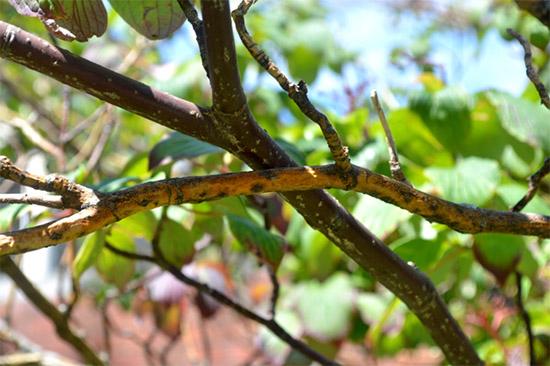Issue 10, July 14, 2014
Golden Canker of Pagoda Dogwood
The pagoda dogwood (Cornus alternifoflia) is an attractive small tree to large shrub with horizontally tiered branches that provide a unique layered appearance. Unlike other dogwoods, the pagoda dogwood's leaves are arranged alternately along the stem; hence the name "alternifolia." While considered to be mostly problem free, the Pagoda dogwood is susceptible to a Cryptodiaporthe canker caused by the fungal pathogen, Cryptodiaporthe corni. This canker is also known as the golden canker, due to the yellow-orange color of infected bark. The canker causes dieback of twigs that can progress from branch tips and into main branches and stems. Once in the main trunk, the tree quickly dies. As far as we know, Cryptodiaporthe corni only attacks pagoda dogwoods. More importantly, it seems to occur on trees that are stressed from heat and drought. It is likely that spores of the fungus are present on orange cankers in the spring, but the infection cycle is not well understood. Most of the dieback seems to occur during host dormancy, as wilted or dead leaves are rarely observed on affected branches.

Golden canker of pagoda dogwood. Golden canker causes the bark on small branches to develop and yellow-orange color that contrasts the greenish purple to reddish purple color of healthy bark.
To manage this disease, use sound horticultural practices to keep your pagoda dogwood healthy. Proper site selection is essential for this species. The pagoda dogwood does best in partial shade with moist, well-drained soil. Slightly acidic conditions are best. Some dogwoods can tolerate exposed, dry sites, but pagoda dogwoods in such locations will likely succumb quickly to Cryptodiaporthe canker. Cankered branches can be pruned 4-6 inches below affected tissues. Promote tree vitality by mulching and provide supplemental irrigation during extended dry weather. (Travis Cleveland)
Author:
Travis Cleveland